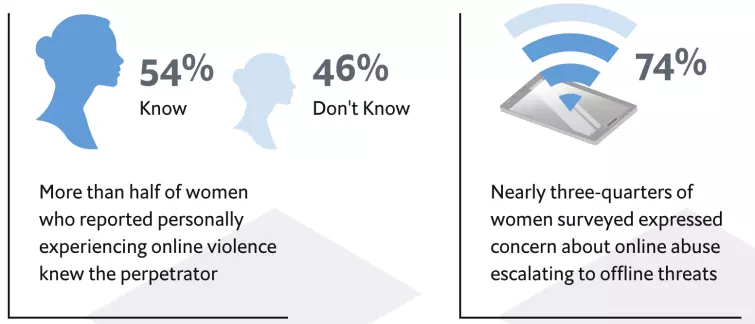The number of romance scams reached a record high in 2022, and this is just the tip of the iceberg when it comes to negative cyber-security trends. Many studies suggest that women are still more at risk of becoming victims of online fraud than other genders. We decided to check if this is really the case, and if it is, what the reasons could be.
We bring you some interesting gender-based online scam statistics and some simple yet effective advice on how to avoid getting scammed and stay safe on the internet.
The internet has become a huge part of our daily life – so much so that its almost impossible to imagine completing routine tasks without it, whether its work or finance-related activities, entertainment, shopping, catching up with friends, or even dating. Unfortunately, as our habits and communication channels are shifting toward the cyber reality, so are potentially unpleasant situations and criminal activities.
Staying safe online nowadays is not easy, especially with the number of scams increasing and new types of online harassment emerging every day. This article aims to help you deal with such dangers by showing examples of different harassment types, statistics, and defense strategies. The research mostly concentrates on women, as were trying to find out if women are really more targeted and susceptible to online frauds, but can be universally applied and helpful to everyone – no matter where you are on the gender spectrum.
What dangers do women face online?
Data breaches, ransomware attacks, and various phishing schemes are equal threats to virtually all demographic groups. However, there are certain online hazards that affect women more often than men, including:
1. Cyberviolence – 85% of girls reported witnessing online harassment
According to research by The Economist, 85% of women around the world have witnessed online violence against other women, both within and outside their networks. Cyberviolence, loosely defined, is an act against another individual that may cause or aggravate physical, emotional, psychological, sexual, or economic damage, and is aided by a computer system. It often includes the emotional exploitations and economical extortions by exhausting an individual's circumstances and vulnerabilities.
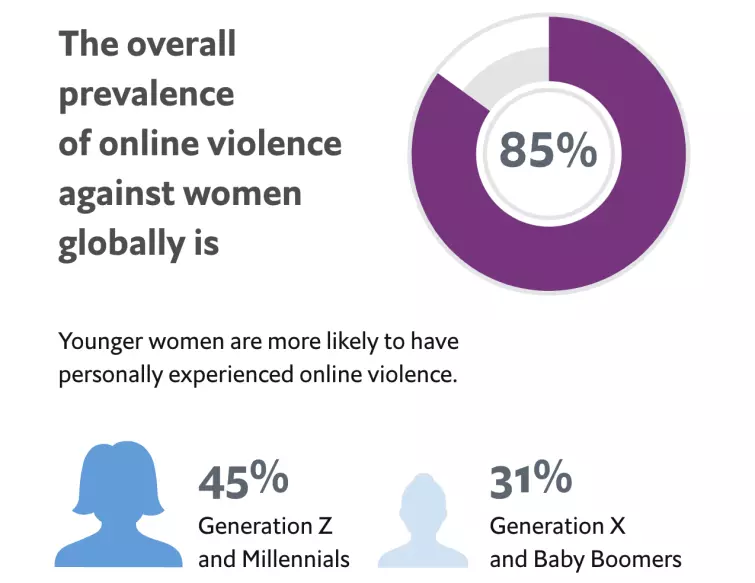
According to the Council of Europe, 58% of girls have personally experienced some form of online harassment in 2020. The persistent problem here is that violence against women online is not taken seriously, especially in some countries, when it is obvious that cyberviolence against women has to be treated the same way as any other form of violence.
2. Sex discrimination and sexual harassment – 46% of women reported sexism
The same survey revealed that approximately 46% of women who experienced online harassment or abuse found it misogynistic or sexist in nature. Online sexual harassment (OSH), in short, is any type of cyberbullying thats of a sexual nature. It is any unwanted interaction online that involves sexual elements.
OHS very often includes the abuse of digital content (images, videos, messages, screenshots, and similar). The abuser posts or comments on various social platforms to make a person feel exploited, humiliated, threatened, or upset, and otherwise sexualized and/or discriminated against.
3. Cyberstalking – 68% of cyberstalking victims are female
According to the University of Bedfordshires cyberstalking research, 68% of people who reported instances of cyberstalking were women. Cyberstalking is the act of stalking or harassing of an individual, group, or even organization by using various electronic means – which is most often the internet. And whilst cyberstalking can solely take place online, it's often accompanied by offline harassment.
Cyberstalking is a criminal offense in many countries and shouldnt be taken lightly, especially since, (according to the same research) almost one-third of people experiencing cyberstalking suffer from PTSD later on. Worse still, 76% of women murdered by their current/ex partner were stalked by them within the 12 months preceding the crime.
4. Identity theft – two out of three identity theft victims in Australia are women
According to an ACCAN and IDCARE project which analyzed 4,000 identity theft cases in Australia, two-thirds of all identity thefts targeted women. The results of this report could be affected by male victims under-reporting incidents of impersonation. Identity thieves may also find female identities more valuable.
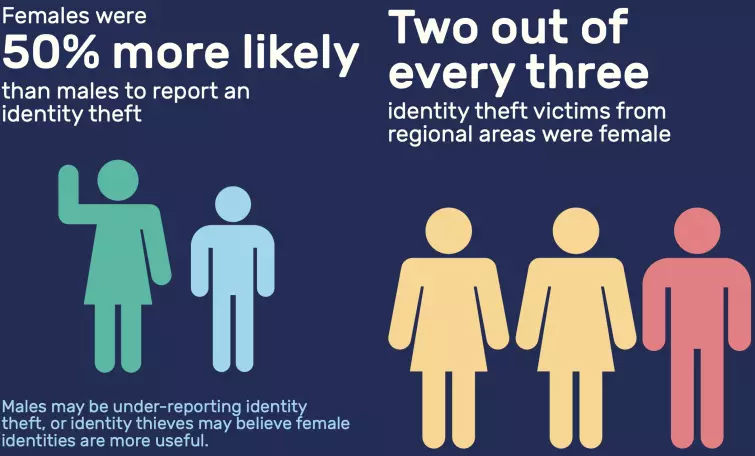
Under the Fair and Accurate Credit Transaction Act (FACT Act) of 2003, Identity theft is defined as a fraud committed or attempted using the identifying information of another person without authority.
5. Catfishing – 64% of catfishers are women
Heres one contrasting statistical fact – when it comes to catfishing, women are more likely to be the perpetrator than the victim. According to background check agencies, 64% of all catfishers are women. Reasons behind catfishing can vary from boredom and loneliness to personality disorders and revenge fantasies. Catfishers often suffer from disorders and psychological conditions such as compulsive lying, PTSD, and low self-esteem.
Catfishing is any faking of personal information and/or images, in order to create a new identity and trick people into believing that this false identity is genuine. A catfisher often steals another persons identity and then uses it to trick others into developing relationships with them, potentially for financial gain.
6. Romance scams – over half of romance scams victims are women
An Action Fraud report reveals that 50% of romance scam victims are women, approximately 39% are men, and the rest of the victims (approximately 11%) didnt want to reveal their gender. In other words, more than half of romance fraud victims are women.
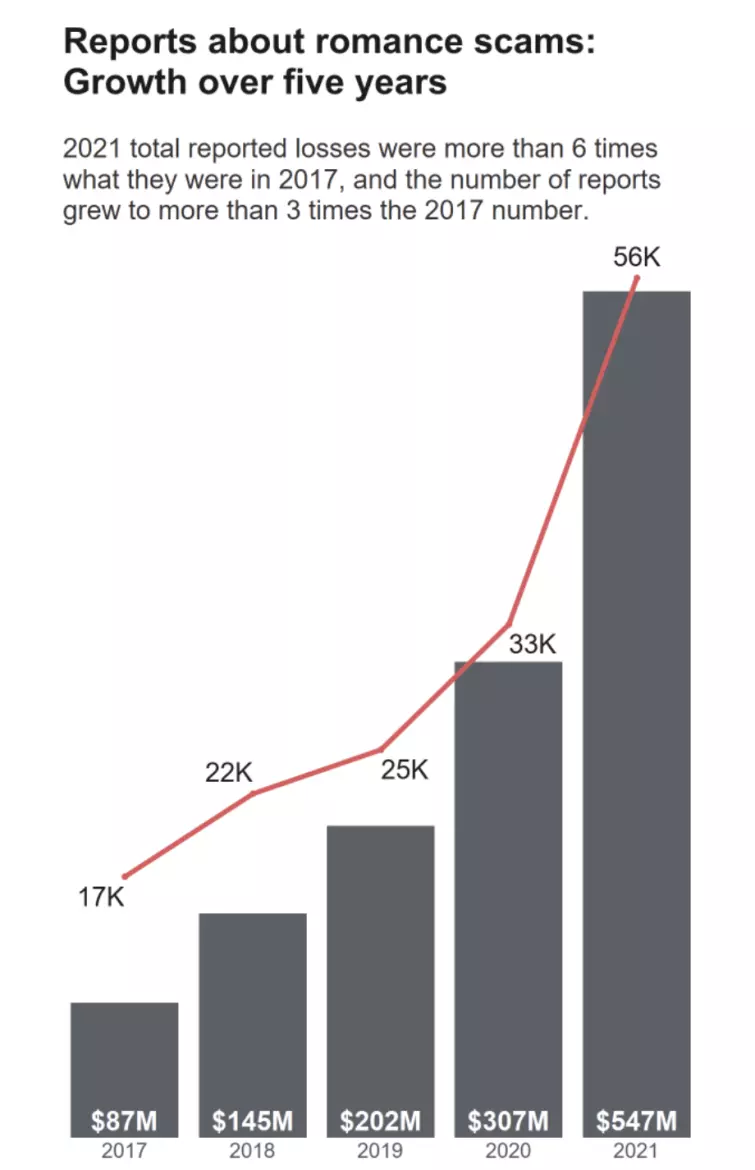
A romance scam happens when a con artist (using a fake identity) tricks their victim into believing they have honest romantic intentions towards them. They eventually gain the victim's affection and trust and leverage these emotions to extort them for money or convince them to carry out financial fraud on their behalf. According to the Federal Trade Commission, the number of romance scams is continuing to rise.
7. Sextortion – In the UK, 88% of sextortion cases involved a male victim
Contrary to what's commonly assumed, and according to the UK's Revenge Porn Helpline, almost nine out of ten sextortion victims in 2021 were male. In most cases (nearly 80%), the offender was a criminal gang, and approximately 11% involved a former or current life partner.
Even though sextortion cases have doubled over the last year, most victims (65%) who made an official report said they didnt receive an appropriate response from the police. One-third of all victims said they experienced a lack of anonymity and trust in police and have dropped their cases. However, when it comes to threat realization (image exposure and such), four-fifths of victims (79%) were actually women.
Sextortion is a type of blackmail where the perpetrator threatens to share intimate information, such as messages, images, or videos belonging to the victim unless they pay them or engage in more sexual activities. The extorter may threaten to expose the materials to the victims family, friends, colleagues, or even to the general public by uploading them to a social (pornographic) platform online.
8. Revenge porn – nearly 90% of revenge porn victims are women
According to the Washington Post, the vast majority (90%) of people who experience manipulation with their pornographic materials (images, videos) are women. As opposed to what many theories suggest, women do not share more nude images than men do. However, revenge porn sites simpy dont value mens pictures – the main reason why nearly all victims of revenge porn are women. On top of this, the social and cultural retributions of taking and keeping these sorts of photos are much harsher for women.
If you look at any revenge porn site, 98% of the people featured are women.
Revenge Porn is the non-consensual distribution and abuse of private materials with sexual content, with the intention to cause embarrassment or any other type of emotional/psychological injury.
9. Doxing – 26% of women harassed online experienced doing
According to an Amnesty International IPSOS MORI poll, 26% of women across the world experienced doxxing, along with other forms of online abuse or harassment. Doxxing can be very dangerous since, in most cases, the victim is unaware that their phone number, home address, Social Security number, sensitive photos, and other personal information is being distributed and abused.
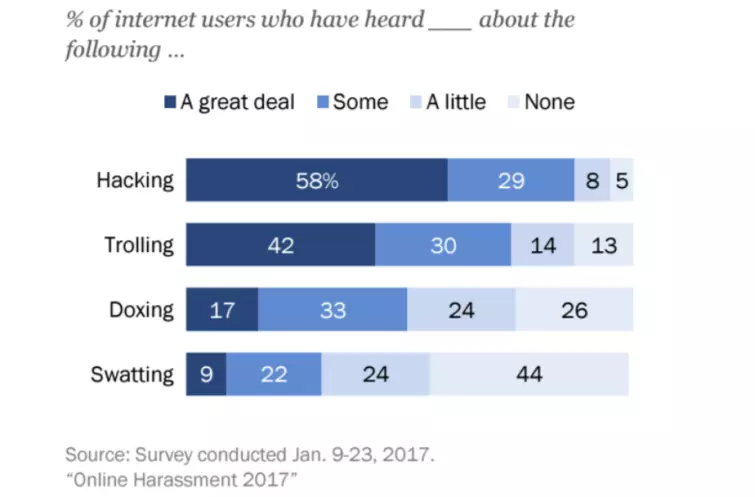
Doxxing (to dox someone) is a term coined from the phrase document-sharing, and it means publicly revealing or sharing someone's private personal data, images, videos, etc. Doxxing is mostly done via online social platforms and with malevolent intent. Although the term dates from the early '90s, unfortunately, many internet users are still not familiar with its meaning.
More online scam statistics
In 2022, so far, the month of January saw the largest number of reports of online scams, while March was the worst month for material losses.
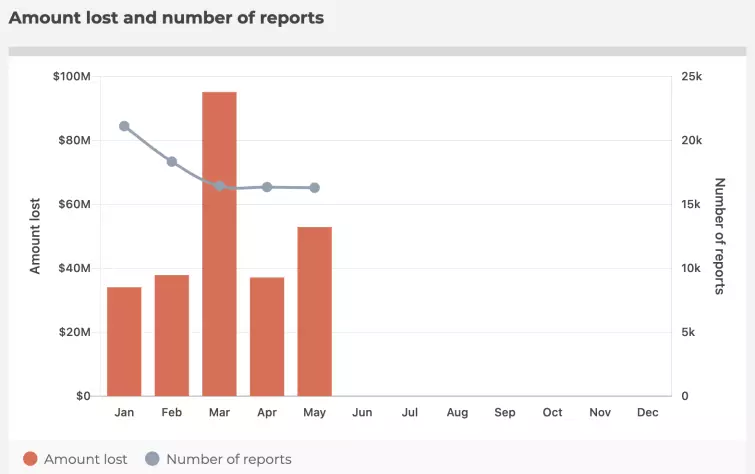
Here are some other interesting online scam statistics.
10. In the countries of SSA and South Asia, theres still a 13-23% gender gap in owning a piece of technology
Women in these parts of the world have a higher tendency to share their mobile devices with other family members, predominantly males, due to economic necessity or conservative social norms. As a result of this technological gender gap, they have less control of their sensitive data, and maintaining privacy is much more challenging compared to independent technology users.
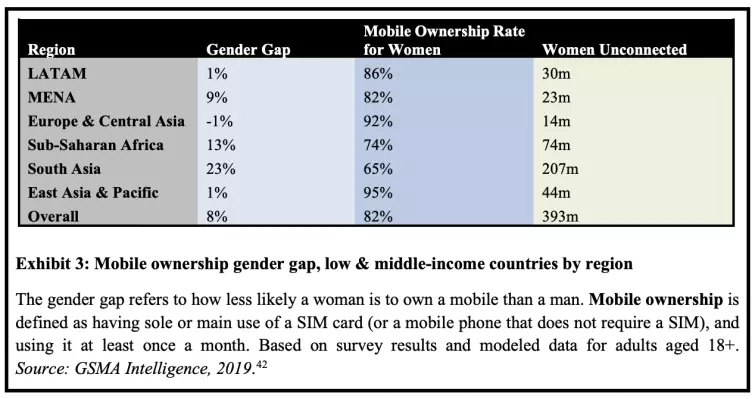
11. 44% of girls and young women think social media companies need to do more to protect them
According to the Free To Be Online report by Plan International, Facebook is the least safe online social platform. Out of 14,071 surveyed girls across 22 countries worldwide, aged 15-25, 39% have suffered harassment on Facebook. Instagram second most unsafe platform with 23% of respondents experiencing cyberbullying, then WhatsApp with 14%, Snapchat with 10%, Twitter with 9%, and TikTok with 6%. Approximately 44% of girls and young women agree that social media companies arent doing enough to protect them.
Rather than free and empowered to express themselves online, girls are all too often harassed, abused and driven from online spaces.
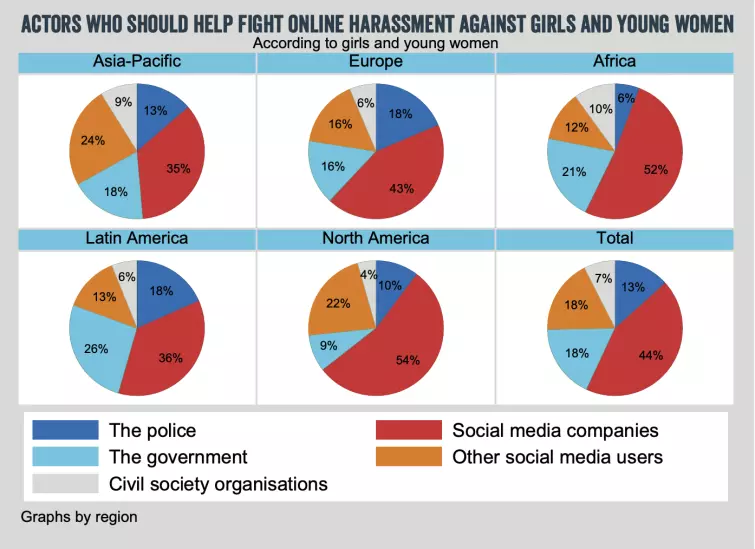
12. Most girls experience their first instance of online harassment in middle adolescence
The Free To Be Online report also reveals that most girls experience their first online abuse between the ages of 14-16. This doesnt come as a surprise, as this is a particularly vulnerable stage in every persons development. Also, some trolls are less confident in attacking more mature girls, as they have more confidence and have learned how to better protect themselves.
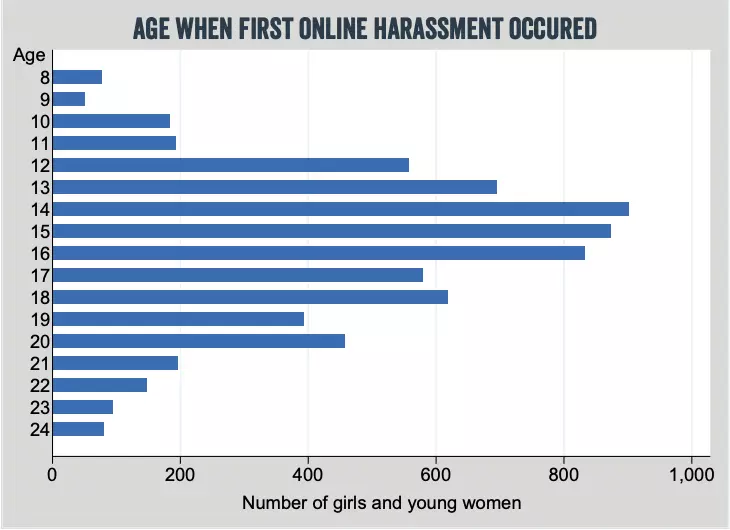
13. More than half of women harassed online knew their perpetrator
According to a report by The Economist, most female victims of online harassment met their abuser in "real life", and 74% of them admitted they fear online threats escalating to offline abuse. This serves as more proof that online and offline violence against women should be seen and treated as equal, and not disparate, issues.
14. 70% of women think online harassment is a major problem
As we can see from the graph above, men and women perceive online harassment differently, and their responses to it can vary significantly based on gender. And so, while 70% of women see online harassment as a major problem, only 54% of men agree. Whats more, 64% of men think that offensive content online is taken too seriously.
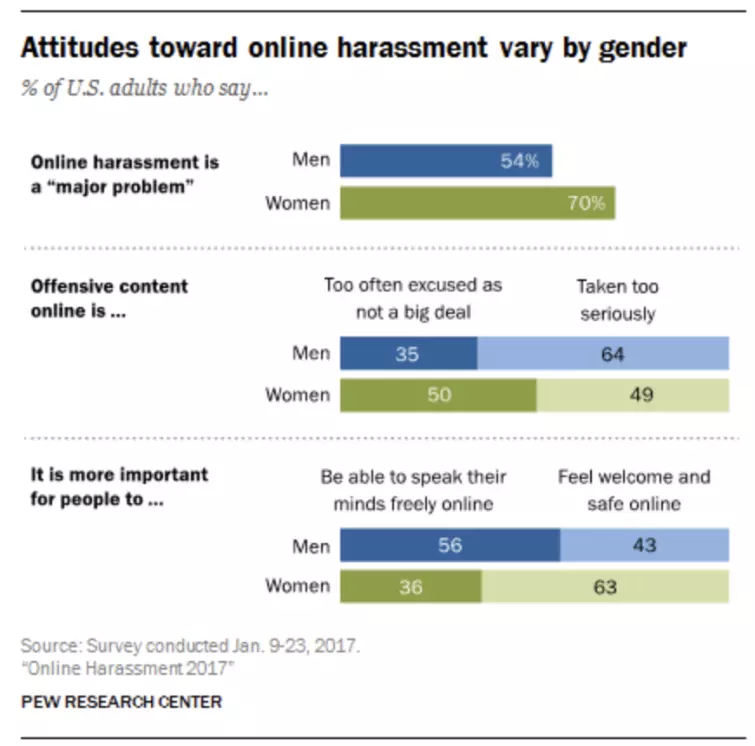
15. Only 14% of women report online abuse to an offline protective agency
The Economist Intelligence Unit found that only 14% of women who have experienced online abuse have reported the behavior to an offline protective agency. Most women (55%) tend to block their perpetrators when faced with cyber violence, 37% rely on online platforms to solve the problem, and 30% reduce their online presence to avoid unpleasant situations.

Make your social media accounts scam-proof
To most people, social media platforms are just pastimes, places you go to take your mind off of things and relax. Still, some discipline is needed – especially since the most popular platforms, such as Facebook, Instagram, and TikTok, have become gold mines for scammers in recent years.
Private profiles are safe profiles
Unless you are an influencer by profession, consider setting all your social media profiles to private by selecting the friends/followers only option. That way, your personal info and the content you share is only visible to a limited number of people, significantly reducing your odds of being targeted by a scammer.
Sensitive personal data, including your phone number, email, real life address, bank account details, etc, should never be available on social networks, no matter how private your accounts are.
Change your data sharing permissions
Social media platforms are notorious for their voracious data collection strategies. But, the good news is that you can manage how much of your data you want to share by opting out of these services. So, check your settings on these apps and review what data youre comfortable sharing.
Think before you click on a link or post something
Nowadays, its mandatory to think twice before opening unexpected emails and clicking on links, even if the sender is a family member, colleague, or friend. This doesnt mean your friends are scamming you – they're most likely victims too.
It's also important to remember that anything you post online cannot be made private again – no matter how secure your privacy settings are. Mechanisms like screenshots mean that posts, images, and DMs can even be shared long after the originals are deleted. So, in addition to remaining wary of incoming messages, you need to think twice before you send or post anything yourself!
Stay up to date
I cant emphasize enough how important is to keep all your apps and devices updated. Software updates remove outdated features, add new ones, and most importantly, patch vulnerabilities and fix bugs to keep you safe.
We may be able to spot obvious scams and malware when we see them, but more advanced threats like trojans are much harder to pinpoint... without help. That's why it's critical to build up your defenses with a good antivirus solution and regular system and app updates. Prevention is far better than a cure in this case.
Change your passwords regularly
Heres another privacy protection tip – dedicate some time to managing your passwords. Make sure they are strong and unique, and change them regularly. Keep your passwords private and do not write them down (somebody could find them) and never share them with anyone (even family members). If you dont have time for all this, or if it sounds like a lot of work, make sure you choose a reliable password manager that will do it for you.
How to stay safe on dating sites?
In terms of privacy, dating websites are like other social media platforms – only worse! Not only do some of them have a repeating history of leaking user data, but they are veritable hotbeds for scams due to users' exposure, rushed decisions, and a lot of emotional decision making. So, on top of the above-mentioned safety measures, you'll need to practice the following checks and precautions.
Perform regular checks for fakes
Many people (ab)use dating websites to pretend theyre someone they are not, play with your emotions, and manipulate you into giving them money, sharing your sensitive personal data, or carrying out illegal activities. So, take your time and perform regular checks on your existing and future contacts/connections in order to avoid fraudsters. Do a thorough research of people youre planning to see or share more about your life with.
Trust your gut feeling
If something seems odd, or too good to be true, then chances are it is. Never ignore your gut feeling and engage in activities that dont feel right, whether offline or online. If a profile or instant message someone sends you seems fake, simply ignore them, and if you start feeling threatened, inform the authorities.
Dont shy away from reporting someone
All social media platforms have report and block options which are there for your safety, so dont ignore them! Same as you wouldnt allow just anyone in your house, you shouldnt allow everyone to access your social media accounts. Blocking somebody isnt a big deal, is reversible, and the person won't even be notified!
How to protect yourself from scams at work?
With the ever-increasing use of technology and our post-COVID remote working habits, its no wonder that job scams are on the rise. Phishing is still the main attack vector for job fraud, but weve also seen an upward trend in ransomware over the last few years.
So whether its a too-good-to-be-true-job opportunity coming from a suspicious email or LinkedIn profile, or its an urgent payment request coming from your colleague, you need to stay on alert. Most importantly, dont rush into any decisions before youve double-checked all the details of the request and verified the person behind it. And never, ever share yours or your companys details before doing these checks.
Set up two-factor authentication
Nowadays, its super easy to connect your social media and work-related accounts to your smartphone – so that each time you try to log in, youll receive a verification code on your phone. In other words, without this code, nobody can get access to your account even if they manage to hack your password. The benefits of this additional layer of security are obvious, and it's one of the simplest and most effective ways to frustrate hackers.
Use all privacy tools available
Many online security companies offer comprehensive business packages and solutions for securing your company from malware and other cyber attacks, so you can always take advantage of those. However, a good business Virtual Private Network (VPN) will suffice at a minimum.
A VPN will redirect and encrypt all your online traffic, block ads and malware, and help you browse and communicate more securely. And, if you opt for a VPN with split tunneling, you can even separate your work-related online traffic from other online activities.
Take your time
Most scammers will try to hurry you into making the wrong decision. They are aware that time is the key factor in the decision-making process, and if they make something seem super-urgent, you wont take the time to properly evaluate the situation. So dont fall for it!
No matter how high priority something might sound, always check the credibility of the messenger and thoroughly inspect the request itself. Use your phone to speak with them or call your supervisor to check what all the urgency is about before clicking on any links, closing any deals, sharing information, or other similar decisions.
Suspect that youre being stalked?
In over 66% of stalking cases, the ex or current intimate partner of the victim was the perpetrator in question. Stalking can start prior, during, or after the relationship and can have a devastating (or even deadly) impact on the victim. The good news is that stalking can often be stopped before the situation escalates. As always, the key is to act in a timely fashion.
If any of these behaviors becomes (or threatens to become) a pattern, you should do the following.
- Gather evidence. To help the police prioritize your case, note down all the occupances and details that you suspect may be instances of stalking. Or better yet, keep a diary of the specific incidents. One incident on its own may not be sufficient to prove stalking, so its important that you record as many of them as possible, even if some of them seem insignificant at the time. Write down all relevant personal information of your own and anything you know about the offender that may be useful to the police. Armed with this information, any police officer can make an official stalking report.
- Report the stalker. In an ideal world, this would be the first thing you do. In reality, youll need at least some proof before making an official report. However, if you feel that your safety has been compromised, contact your local police without delay. If you are unsure how serious your situation is or what to do next, contact the National Stalking Helpline or a similar agency in your country. If possible, its also a good idea to hire a specialized lawyer or law firm to provide you with legal advice and support.
- Stop all communication with the stalker. Its natural to feel the urge to defend yourself from harassment, debunk a scam, or refute a lie you hear about yourself on social media. However, this is exactly what your stalker wants. So, try your best to avoid any sort of confrontation with the stalker, offline or online, as this will only further provoke their behavior.
- Go to your safe place/person and increase the safety levels at your home. If possible, the best thing to do is to stay with a family member or friend until the situation resolves and you feel safe again. If you dont have this option, do the best you can to safeguard your home. Keep your curtains closed and your doors locked, preferably at all times. Install deadbolts, security cameras, motion-activated lights, and home security systems. In any case, you should inform people you trust about what youre going through, and its not a bad idea to notify your landlord, neighbor, and coworkers about the situation. That way, they can provide you with physical protection and emotional support when/if necessary.
- Avoid being alone. Stay away from dark and places and parts of the city youre not familiar with, and stay in public areas when heading out. Try and think of anyone who could be a link between you and the stalker and cut the ties with them to prevent them from revealing your whereabouts.
- Change all your passwords. Protecting yourself online is equally important as protecting yourself offline. As soon as possible, block the potential stalker and change passwords on all your social networks and communication channels. Increase your online security by setting up all your profiles to private, and make sure approval is needed before anyone can post anything on your timeline.

